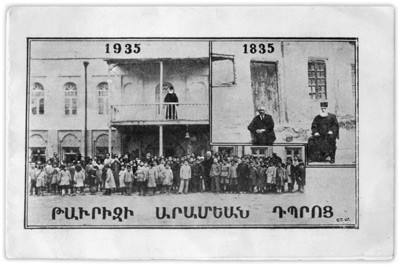In the late fourth century A.D., after the partition of Armenia between Byzantium and Persia, the Armenian province of Parskahayk was incorporated into Atropatene (Atrpatakan in Armenian), today known as Iranian Azerbaijan. The Armenian population has remained in the region since then, although sensibly diminished in number since the mid-twentieth century.
The capital of Iranian Azerbaijan, Tabriz, had a strong Armenian community in the nineteenth and twentieth centuries, including the headquarters of the Prelacy of Iranian Azerbaijan. Bishop Sahak Satunian undertook the creation of an eight-year school there, which was founded on February 19, 1851, in the courtyard of the church of the neighborhood of Ghala. The first principal was Rev. Fr. Hovsep (last name unknown). The school was called Nersisian in honor of St. Nerses Shnorhali, and kept this name until 1875, when it was renamed Aramian in honor of the Iranian Armenian benefactor of the same name. Initially it had 60 students, and their number reached one hundred in the following year.
The curriculum of the Aramian School was in Armenian, and included the teaching of foreign languages (Farsi, Russian, and French). It was initially a boys’ school. In 1887, it was moved to the building of the Annayan School, built by the Tumaniants family, and merged with the girls’ school, becoming a co-ed institution named Aramian-Annayan Armenian School. After the foundation of the Diocesan Central High School in 1909, the Aramian School became one of its preparatory schools. Raffi (Hakob Melik Hakobian, 1835-1888), the great novelist, and famous linguist Hrachia Ajarian (1876-1953) were among the teachers at the school in different times.
In 1888, a print shop was established at the school by Archbishop Stepanos Mkhitarian through the donation of Hovhannes Hovnanian, an Armenian from Moscow. It started printing books in 1889 and was later moved to the Prelacy. It printed a total of 63 books until 1920.
The Aramian School had a significant impact on the education of the Armenian community of Iran. It had about 1,300 graduates until 1936, when Reza Shah Pahlavi (1925-1941), king of Iran, banned the teaching of Armenian language in Iran and closed all Armenian schools as part of his authoritarian policies.

